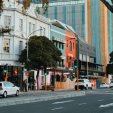Tickets for kids from R10! And you can bring your own food
2010 Lead Stadium Work Begins in Johannesburg
The site of Johannesburg's FNB Stadium has been handed over to the builders to built 2010 Soccer World Cup Stadium Johannesburg
The site of Johannesburg's FNB Stadium has been handed over to the builders for a R1.5-billion revamp that will increase its capacity to 94 000 seats - under a roof that leaves the Johannesburg 2010 soccer stadium itself open to the sunlight - as South Africa gets down to work in preparation for the 2010 Fifa World Cup.Plans for the construction of four stadiums and upgrading of six others in South Africa's nine 2010 host cities has been completed, and their funding secured, and construction work on all the venues is due to begin over the next few months.
The FNB Stadium - also known as Soccer City Stadium - will host the World Cup opening ceremony, first match and final game, as well as five first-round matches, one second-round match and one quarter-final.
The contract for revamping the 2010 soccer stadium in Johannesburg was awarded to Grinaker-LTA Construction, a subsidiary of JSE-listed The Aveng Group, in a joint venture with Interbeton bv, part of the Royal BAM Group from Holland.
According to the SA Press Assocation (Sapa), German company HBM Stadien-und Sportstaettenbau GmbH - a specialist stadium construction company involved in the 2006 World Cup, and also part of the Royal BAM Group - will be contributing its expertise to renovating the stadium to become on of the 2010 Soccer World Cup Stadiums .
Construction of the Johannesburg stadium is scheduled to begin in two weeks, and the soccer stadium is expected to be completed well before the World Cup begins in June 2010.
Speaking at Wednesday's handover and sod-turning ceremony, Johannesburg Mayor Amos Masondo said the city was "ready and prepared to take on the challenge of hosting all relevant events and matches in 2010 ."
R1bn for 2010 legacy projects
Masondo announced that the city had set aside R1-billion for legacy projects aimed at ensuring that Joburg continued to benefit from the 2010 World Cup long after the final whistle was blown.
Seven legacy projects had been identified, Masondo said, in order to "stimulate economic and social development in previously neglected areas". One of the projects will involve the replacement of inner city public utilities such as outdoor refuse bins, benches, vendor stalls, play areas, pathways and ablution facilities.
Others include upgrading undeveloped soccer fields across the city; greening Klipspruit River and its tributaries in Soweto; and building an indoor sports centre complete with Olympic-sized swimming pool and gymnastics hall in Soweto.
R385m for safety and security
Masondo added that Johannesburg had allocated about R385-million for safety and security during the 2010 Soccer World Cup.
"Safety and security planning for 2010 is at an advanced stage," he said. "The city will be extending the ... closed circuit television camera surveillance system throughout the city and linking this with a national database containing biometric data."
The Johannesburg Metropolitan Police Department would train and employ 500 new officers every year, he said, increasing its total number of officers to 4 000 by 2010.
At the same time, the city's safety plans would be integrated into the country's national 2010 security strategy, and Joburg's metro police would be working closely with the South African Police Service and the national intelligence community.
"We want to host a people-friendly and incident-free World Cup and ensure that visitors enjoy the many sights of Johannesburg in a safe and secure environment," Masondo said.
"Let me assure you that our plans and our preparations are on track, on time and within budget. We are ready, we are willing and we are able to host the showpiece events of the world's greatest sporting spectacle."
Source: SouthAfrica.info reporter, BuaNews and City of Johannesburg
Molo Says: "Download our Google Earth Maps of South Africa and all the World Cup 2010 Stadiums."









